Effects of Briquetting and High Pyrolysis Temperature on Hydrolysis Lignin Char Properties and Reactivity in CO-CO2-N2 Conditions
Abstract
1. Introduction
2. Experimental Procedure
2.1. Materials
2.2. Pre-Treatment
2.3. Slow Pyrolysis
2.4. Thermo-Gravimetric Analysis and Mass Spectrometry
2.5. Proximate Analysis of the Samples
2.6. Apparent Density Measurements
2.7. Specific Surface Area (SSA), Pore Volume, and Pore Size Distribution
2.8. Dynamic Reactivity Tests
3. Results and Discussion
3.1. Hydrolysis Lignin
3.2. Char and Nut Coke Properties
3.3. Behavior of Hydrolysis Lignin in Slow Pyrolysis
3.4. Surface Area and Porosity of the Chars and Nut Coke
3.5. Lignin Char and Nut Coke Reactivity
4. Conclusions
Author Contributions
Funding
Institutional Review Board Statement
Informed Consent Statement
Data Availability Statement
Acknowledgments
Conflicts of Interest
References
- Ramasamy, S.; Moghtaderi, B. Dielectric properties of typical australian wood-based biomass materials at microwave frequency. Energy Fuels 2010, 24, 4534–4548. [Google Scholar] [CrossRef]
- Yip, K.; Xu, M.; Li, C.-Z.; Jiang, S.P.; Wu, H. Biochar as a Fuel: 3. Mechanistic Understanding on Biochar Thermal Annealing at Mild Temperatures and Its Effect on Biochar Reactivity. Energy Fuels 2011, 25, 406–414. [Google Scholar] [CrossRef]
- Koskela, A.; Suopajärvi, H.; Mattila, O.; Uusitalo, J.; Fabritius, T. Lignin from Bioethanol Production as a Part of a Raw Material Blend of a Metallurgical Coke. Energies 2019, 12, 1533. [Google Scholar] [CrossRef]
- Agirre, I.; Griessacher, T.; Rösler, G.; Antrekowitsch, J. Production of charcoal as an alternative reducing agent from agricultural residues using a semi-continuous semi-pilot scale pyrolysis screw reactor. Fuel Process. Technol. 2013, 106, 114–121. [Google Scholar] [CrossRef]
- Suopajärvi, H.; Pongrácz, E.; Fabritius, T. The potential of using biomass-based reducing agents in the blast furnace: A review of thermochemical conversion technologies and assessments related to sustainability. Renew. Sustain. Energy Rev. 2013, 25, 511–528. [Google Scholar] [CrossRef]
- Suopajärvi, H.; Pongrácz, E.; Fabritius, T. Bioreducer use in Finnish blast furnace ironmaking—Analysis of CO2 emission reduction potential and mitigation cost. Appl. Energy 2014, 124, 82–93. [Google Scholar] [CrossRef]
- Kirubakaran, V.; Sivaramakrishnan, V.; Nalini, R.; Sekar, T.; Premalatha, M.; Subramanian, P. A review on gasification of biomass. Renew. Sustain. Energy Rev. 2009, 13, 179–186. [Google Scholar] [CrossRef]
- Bridgwater, A.V.; Meier, D.; Radlein, D. An overview of fast pyrolysis of biomass. Org. Geochem. 1999, 30, 1479–1493. [Google Scholar] [CrossRef]
- Ghysels, S.; Ronsse, F.; Dickinson, D.; Prins, W. Production and characterization of slow pyrolysis biochar from lignin-rich digested stillage from lignocellulosic ethanol production. Biomass Bioenergy 2019, 122, 349–360. [Google Scholar] [CrossRef]
- Suopajärvi, H.; Kemppainen, A.; Haapakangas, J.; Fabritius, T. Extensive review of the opportunities to use biomass-based fuels in iron and steelmaking processes. J. Clean. Prod. 2017, 148, 709–734. [Google Scholar] [CrossRef]
- Lovel, R.R.; Vining, K.R.; Dell ’amico, M. The Influence of Fuel Reactivity on Iron Ore Sintering. ISIJ Int. 2009, 49, 195–202. [Google Scholar] [CrossRef]
- Ooi, T.C.; Aries, E.; Ewan, B.C.R.; Thompson, D.; Anderson, D.R.; Fisher, R. The study of sunflower seed husks as a fuel in the iron ore sintering process. Miner. Eng. 2008, 21, 167–177. [Google Scholar] [CrossRef]
- Ruan, X.; Sun, Y.; Du, W.; Tang, Y.; Liu, Q.; Zhang, Z. Formation, characteristics, and applications of environmentally persistent free radicals in biochars: A review. Bioresour. Technol. 2019, 281, 457–468. [Google Scholar] [PubMed]
- Haensel, T.; Comouth, A.; Lorenz, P.; Ahmed, S.I.U.; Krischok, S.; Zydziak, N. Pyrolysis of cellulose and lignin. Appl. Surf. Sci. 2009, 255, 8183–8989. [Google Scholar] [CrossRef]
- Gavel, D.J.; Adema, A.; van der Stel, J.; Kwakernaak, C.; Sietsma, J.; Boom, R. Melting Behaviour of Iron Ore Pellet Bed under Nut Coke Mixed Charge Conditions. ISIJ Int. 2020, 60, 451–462. [Google Scholar] [CrossRef]
- Demirbas, A. Effects of temperature and particle size on bio-char yield from pyrolysis of agricultural residues. J. Anal. Appl. Pyrolysis 2004, 72, 243–248. [Google Scholar] [CrossRef]
- Toloue Farrokh, N.; Suopajärvi, H.; Mattila, O.; Umeki, K.; Phounglamcheik, A.; Romar, H. Slow pyrolysis of by-product lignin from wood-based ethanol production– A detailed analysis of the produced chars. Energy 2018, 164, 112–123. [Google Scholar] [CrossRef]
- Cassel, B.; Menard, K. Proximate Analysis of Coal and Coke using the STA 8000 Simultaneous Thermal Analyzer; PerkinElmer, Inc.: Shelton, CT, USA, 2012. [Google Scholar]
- Basu, P. Biomass Gasification and Pyrolysis: Practical Design and Theory; Academic Press: Amsterdam, The Netherlands, 2010. [Google Scholar]
- Naderi, M. Surface Area: Brunauer-Emmett-Teller (BET). Prog. Filtr. Sep. 2015, 14, 585–608. [Google Scholar]
- Thommes, M.; Kaneko, K.; Neimark, A.V.; Olivier, J.P.; Rodriguez-Reinoso, F.; Rouquerol, J. Physisorption of gases, with special reference to the evaluation of surface area and pore size distribution (IUPAC Technical Report). Pure Appl. Chem. 2015, 87, 1052–1069. [Google Scholar] [CrossRef]
- Ryu, Z.; Zheng, J.; Wang, M. Porous structure of pan-based activated carbon fibers. Carbon 1998, 36, 427–432. [Google Scholar] [CrossRef]
- Figueroa-Gerstenmaier, S.; Siperstein, F.R.; Celzard, A.; Fierro, V. Application of Density Functional Theory for Determining Pore-Size Distributions of Microporous Activated Carbons. Adsorpt. Sci. Technol. 2014, 32, 23–35. [Google Scholar] [CrossRef]
- Roberts, D.G.; Harris, D.J. A kinetic analysis of coal char gasification reactions at high pressures. Energy Fuels 2006, 20, 2314–2320. [Google Scholar] [CrossRef]
- Guo, W.; Xue, Q.; Liu, Y.; Guo, Z.; She, X.; Wang, J. Kinetic analysis of gasification reaction of coke with CO2 or H2O. Int. J. Hydrogen Energy 2015, 40, 13306–13313. [Google Scholar] [CrossRef]
- Gan, M.; Lv, W.; Fan, X.; Chen, X.; Ji, Z.; Jiang, T. Gasification Reaction Characteristics between Biochar and CO2 as well as the Influence on Sintering Process. Adv. Mater. Sci. Eng. 2017, 2017, 9404801. [Google Scholar] [CrossRef]
- Babich, A.; Senk, D.; Gudenau, H.W. Effect of coke reactivity and nut coke on blast furnace operation. Ironmak. Steelmak. 2009, 36, 222–229. [Google Scholar] [CrossRef]
- Mousa, E.A.; Senk, D.; Babich, A.; Gudenau, H.W. Influence of nut coke on iron ore sinter reducibility under simulated blast furnace conditions. Ironmak. Steelmak. 2010, 37, 219–228. [Google Scholar] [CrossRef]
- Zhao, W.; Chu, M.; Wang, H.; Liu, Z.; Tang, J.; Ying, Z. Effect of Introducing Coke into Ore Layer on Softening-melting-dropping Characteristics of Vanadium-titanium Mixed Burden under Simulating BF Conditions. ISIJ Int. 2018, 58, 1989–1998. [Google Scholar] [CrossRef]
- Cao, J.; Xiao, G.; Xu, X.; Shen, D.; Jin, B. Study on carbonization of lignin by TG-FTIR and high-temperature carbonization reactor. Fuel Process. Technol. 2013, 106, 41–47. [Google Scholar] [CrossRef]
- Terui, K.; Kashihara, Y.; Hirosawa, T.; Nouchi, T. Optimization of Coke Mixed Charging Based on Discrete Element Method. ISIJ Int. 2017, 57, 1804–1810. [Google Scholar] [CrossRef]
- Yang, H.; Yan, R.; Chen, H.; Zheng, C.; Lee, D.H.; Liang, D.T. In-depth investigation of biomass pyrolysis based on three major components: Hemicellulose, cellulose and lignin. Energy Fuels 2006, 20, 388–393. [Google Scholar] [CrossRef]
- Fushimi, C.; Araki, K.; Yamaguchi, Y.; Tsutsumi, A. Effect of heating rate on steam gasification of biomass. 2. Thermogravimetric-mass spectrometric (TG-MS) analysis of gas evolution. Ind. Eng. Chem. Res. 2003, 42, 3929–3936. [Google Scholar] [CrossRef]
- Yang, H.; Yan, R.; Chen, H.; Lee, D.H.; Zheng, C. Characteristics of hemicellulose, cellulose and lignin pyrolysis. Fuel 2007, 86, 1781–1788. [Google Scholar] [CrossRef]
- Brebu, M.; Tamminen, T.; Spiridon, I. Thermal degradation of various lignins by TG-MS/FTIR and Py-GC-MS. J. Anal. Appl. Pyrolysis 2013, 104, 531–539. [Google Scholar] [CrossRef]
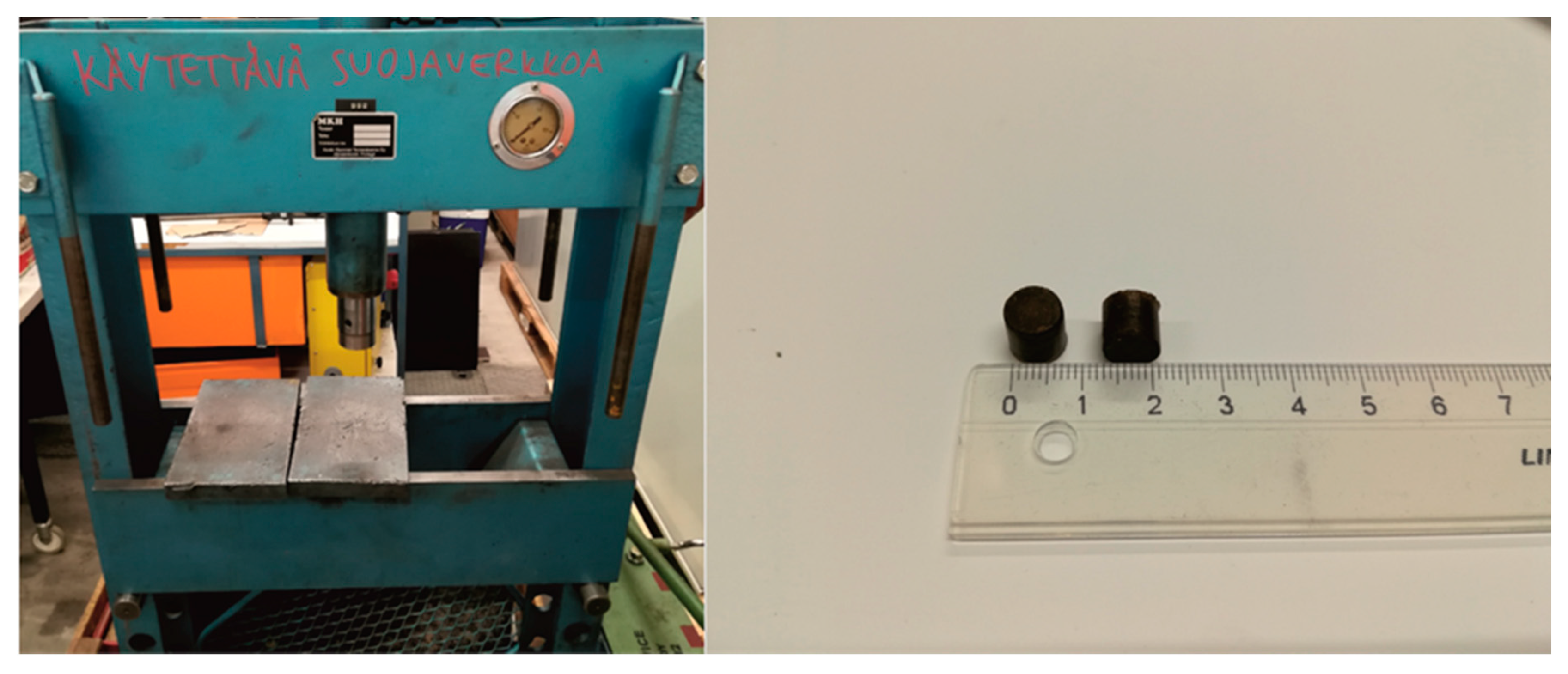
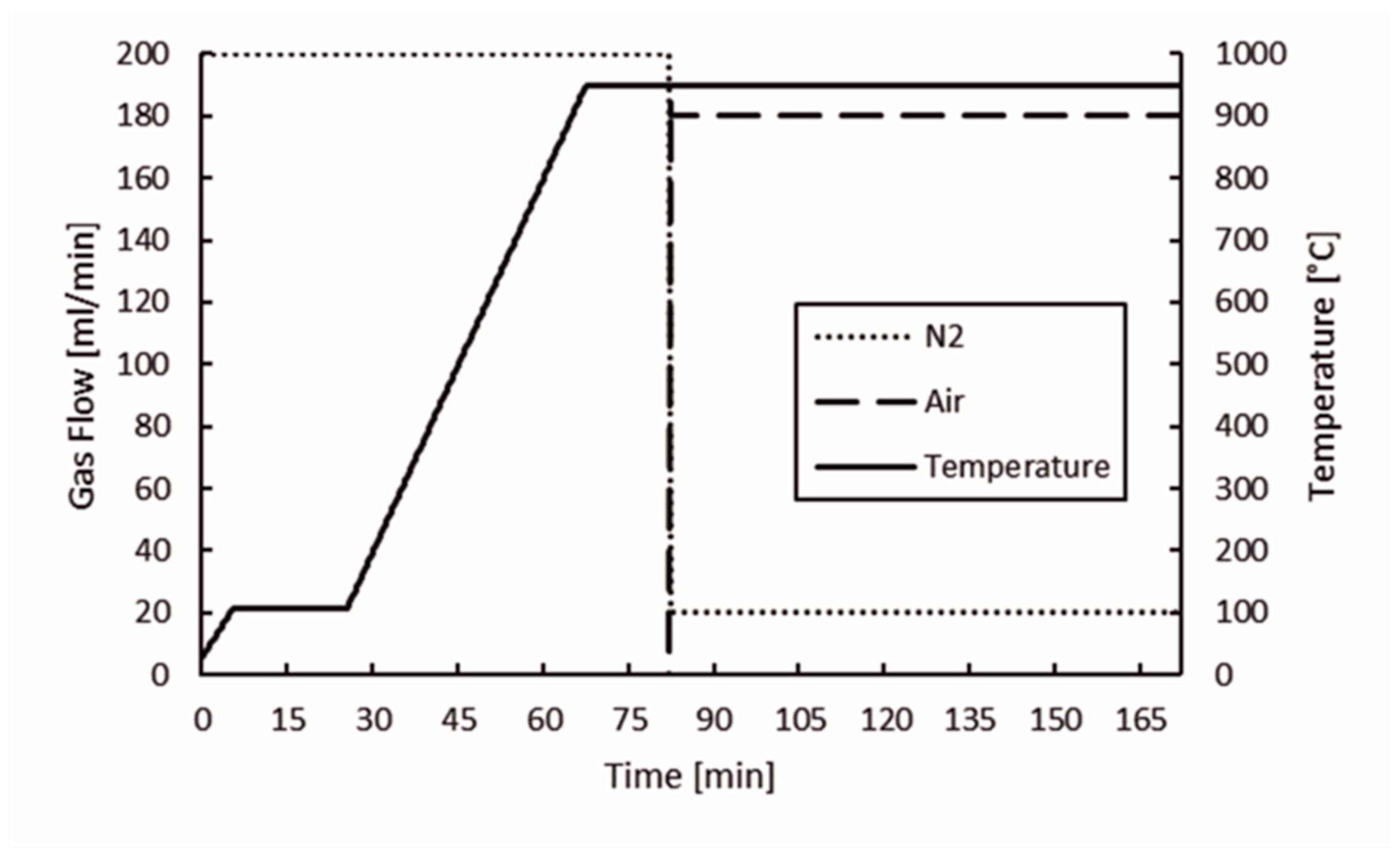
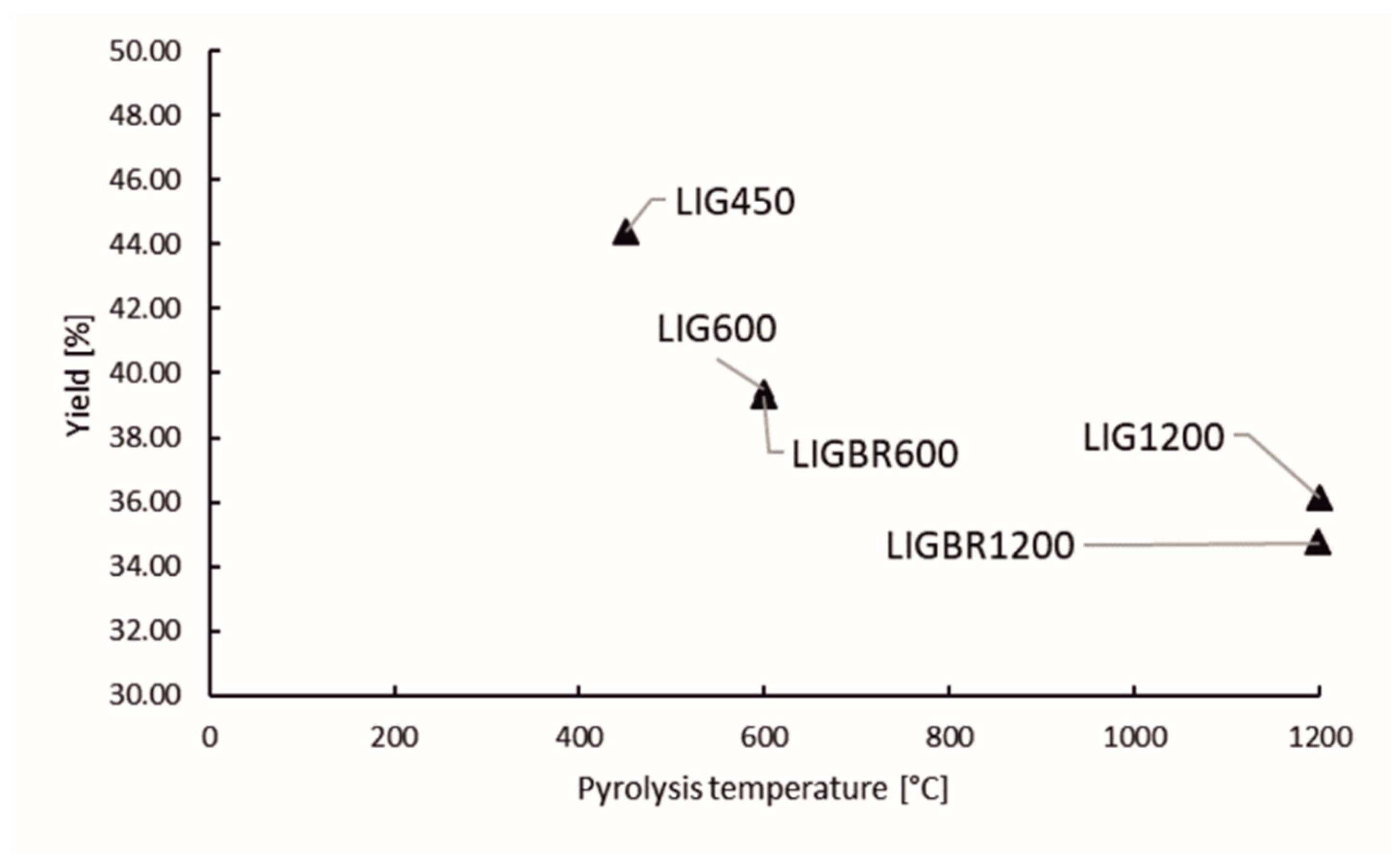

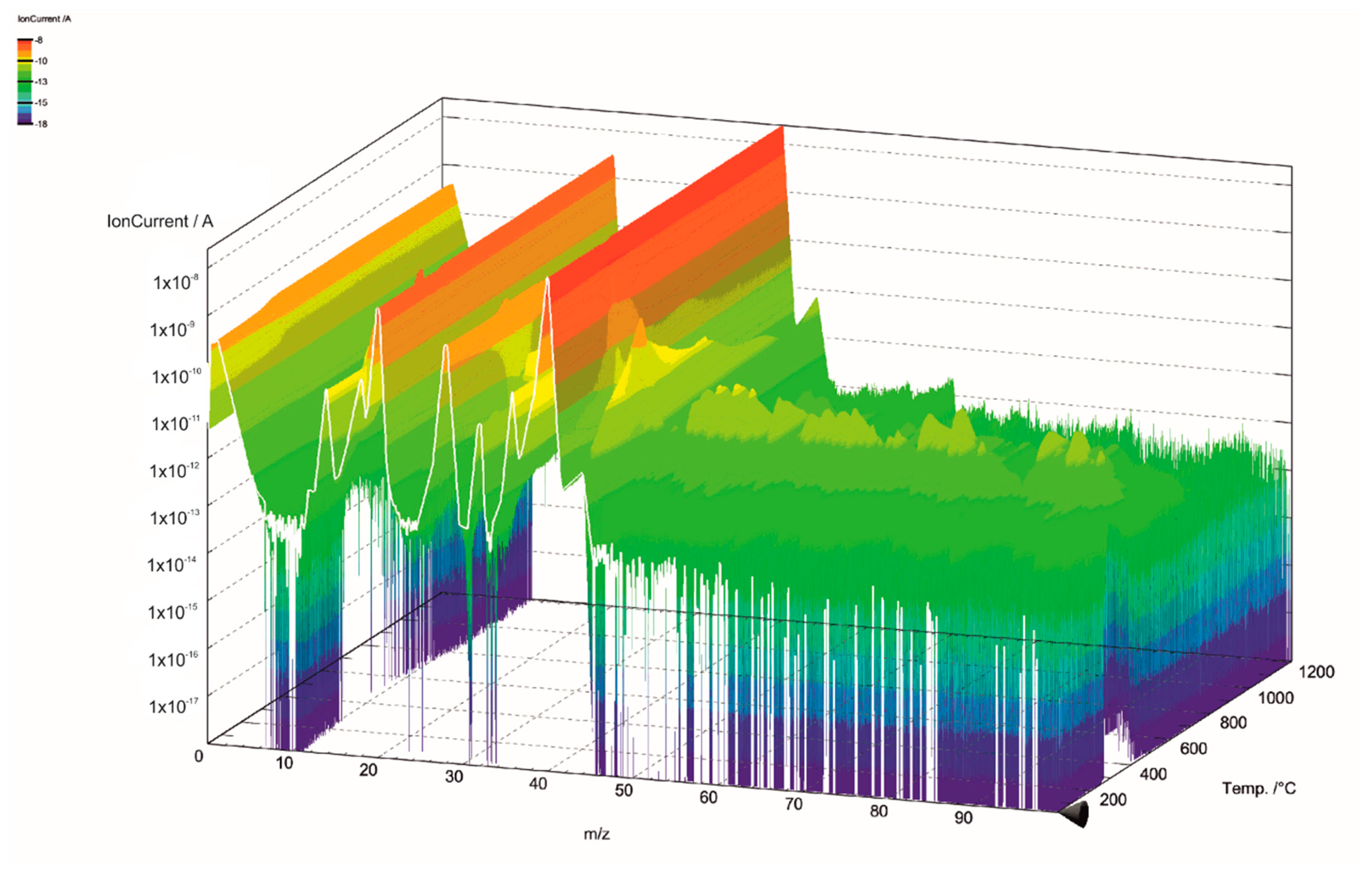
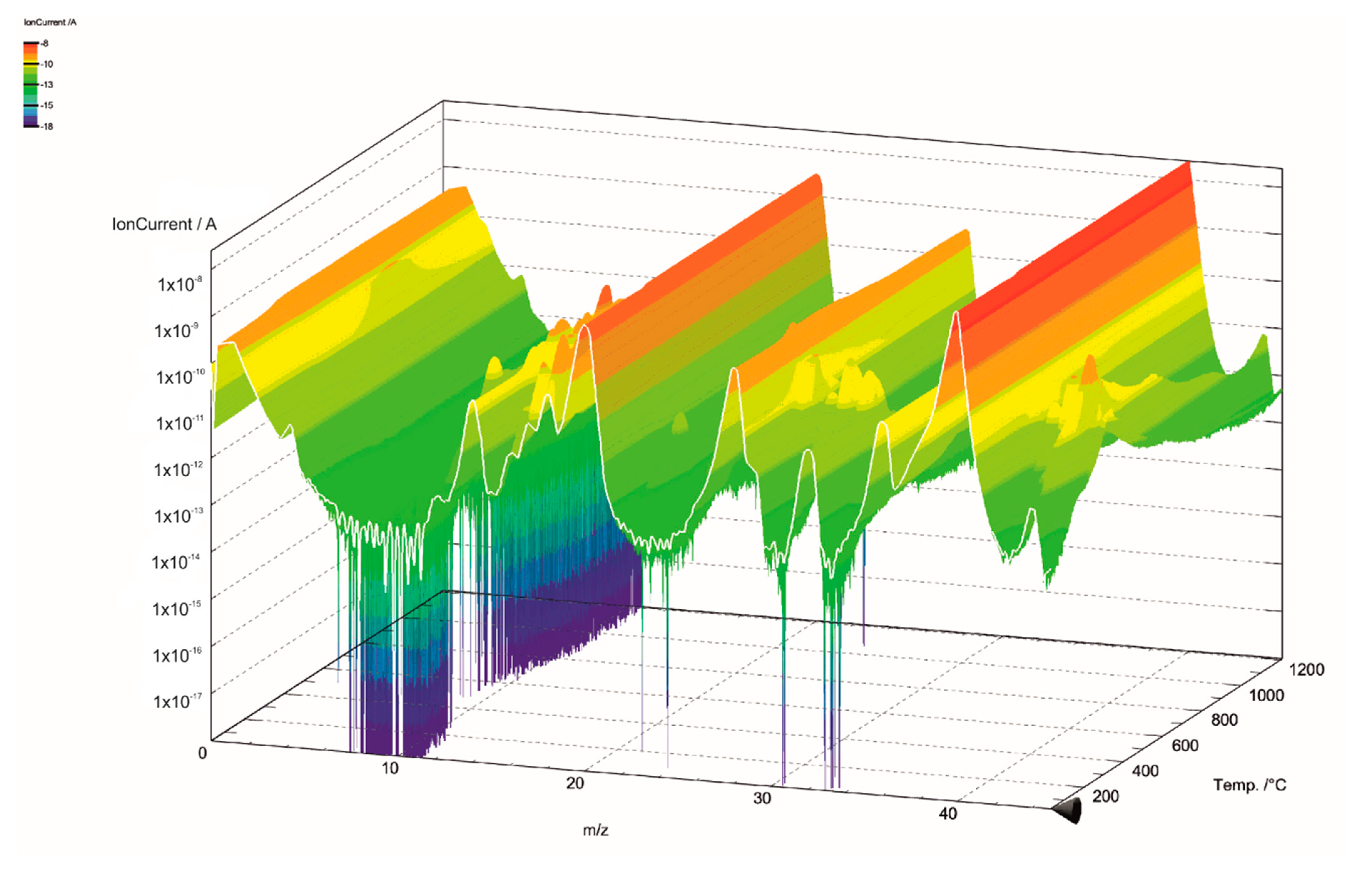
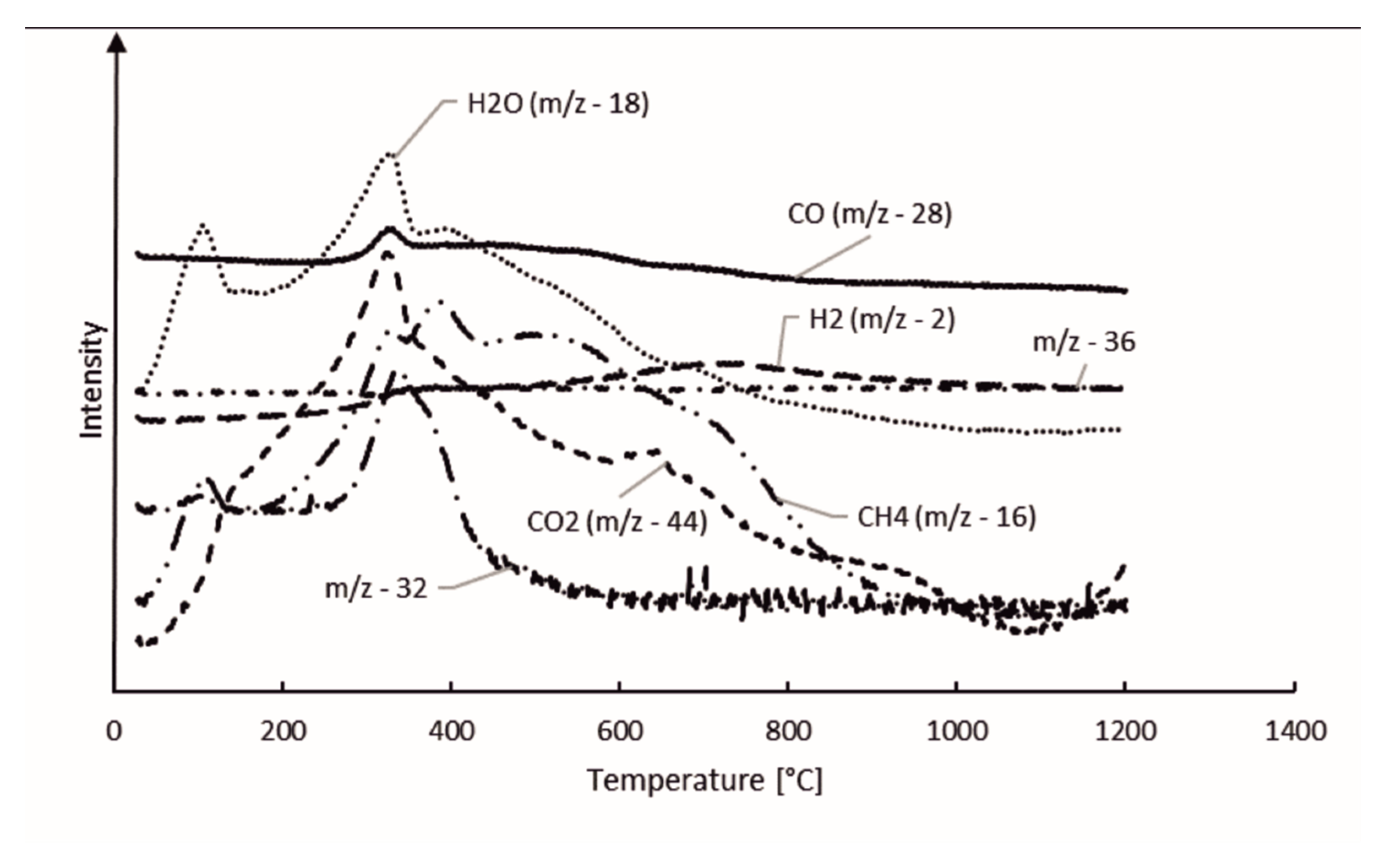



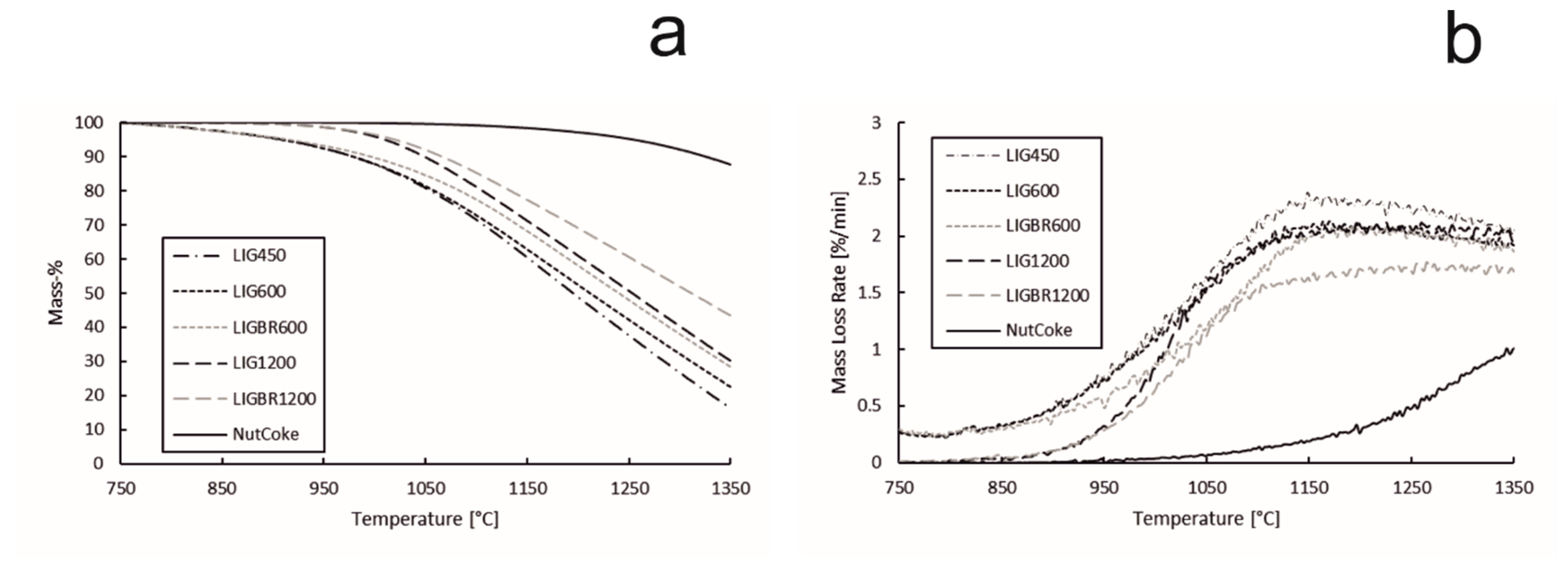
| Properties | Hydrolysis Lignin | Standard/Analysis Methods | ||
|---|---|---|---|---|
| Total Moisture (105 °C) | [m%] | 5.300 | SFS-EN 14774-2, CEN/TS 15414-2, ISO 589 | |
| Ultimate analysis | C | %, d. b. | 61.000 | SFS-EN ISO 16948, SFS-EN 15407, ISO 29541 |
| H | %, d. b. | 6.100 | SFS-EN ISO 16948, SFS-EN 15407, ISO 29541 | |
| O | %, d. b. | 31.900 | SFS-EN ISO 16993 | |
| N | %, d. b. | 0.690 | SFS-EN ISO 16948, SFS-EN 15407, ISO 29541 | |
| S | %, d. b. | 0.120 | ASTM D 4239 (mod), SFS-EN ISO 16994 | |
| Proximate analysis | Volatile matter | %, d. b. | 70.900 | SFS-EN ISO 18123, SFS-EN 15402, ISO 562 |
| Ash content | %, d. b. | 0.200 | SFS-EN ISO 18122, SFS-EN 15403, ISO 1171 | |
| Fixed Carbon | %, d. b. | 28.900 | Determined by difference | |
| Ash composition | Cl | %, d. b. | 0.002 | SFS-EN ISO 10304-1 |
| F | %, d. b. | <0.001 | SFS-EN ISO 10304-1 | |
| Br | %, d. b. | <0.001 | SFS-EN ISO 10304-1 | |
| Ca | mg/kg, d. b. | 290.000 | SFS-EN ISO 11885 | |
| Mg | mg/kg, d. b. | 51.000 | SFS-EN ISO 11885 | |
| Na | mg/kg, d. b. | <10.000 | SFS-EN ISO 11885 | |
| K | mg/kg, d. b. | 130.000 | SFS-EN ISO 11885 | |
| P | mg/kg, d. b. | 74.000 | SFS-EN ISO 11885 | |
| S | mg/kg, d. b. | 1100.000 | SFS-EN ISO 11885 | |
| Fe | mg/kg, d. b. | 810.000 | SFS-EN ISO 11885 | |
| Al | mg/kg, d. b. | 14.000 | SFS-EN ISO 11885 | |
| Si | mg/kg, d. b. | <10.000 | SFS-EN ISO 11885 | |
| Ti | mg/kg, d. b. | <1.000 | SFS-EN ISO 11885 | |
| Mn | mg/kg, d. b. | 41.000 | SFS-EN ISO 11885 | |
| Ba | mg/kg, d. b. | 4.800 | SFS-EN ISO 11885 | |
| Cr | mg/kg, d. b. | 15.000 | SFS-EN ISO 11885 | |
| Cu | mg/kg, d. b. | <1.000 | SFS-EN ISO 11885 | |
| Ni | mg/kg, d. b. | 12.000 | SFS-EN ISO 11885 | |
| Zn | mg/kg, d. b. | 12.000 | SFS-EN ISO 11885 | |
| Pb | mg/kg, d. b. | 1.300 | SFS-EN ISO 11885 | |
| V | mg/kg, d. b. | <1.000 | SFS-EN ISO 11885 | |
| Ar | mg/kg, d. b. | <0.500 | SFS-EN ISO 17294-2 |
| Proximate Analysis [m%], d. b. | Apparent Density (kg/m3) | |||||
|---|---|---|---|---|---|---|
| Sample | Total Moisture (105 °C) [m%] | Volatile Matter | Ash Content | Fixed Carbon | Before Pyrolysis | After Pyrolysis |
| Lignin | 55.40 | 70.90 | 0.20 | 28.90 | x | x |
| LIG450 | 1.25 | 18.70 | 2.01 | 79.29 | x | x |
| LIG600 | 0.66 | 8.22 | 2.19 | 89.58 | x | x |
| LIGBR600 | 0.71 | 6.39 | 1.29 | 91.62 | 1065.91 | 1113.47 |
| LIG1200 | 0.30 | 1.53 | 1.30 | 97.16 | x | x |
| LIGBR1200 | 0.23 | 1.31 | 0.92 | 97.54 | 1022.90 | 1366.25 |
| Nut coke | 0.00 | 0.14 | 11.45 | 88.41 | x | x |
| Properties | Unit | LIG450 | LIG600 | LIGBR600 | LIG1200 | LIGBR1200 | Nut Coke |
|---|---|---|---|---|---|---|---|
| Mass Loss | [%] | 86.55 | 79.41 | 74.59 | 69.99 | 56.80 | 12.21 |
| Mass Loss Rate | [%/min] | 1.69 | 1.76 | 1.67 | 1.95 | 1.68 | 1.01 |
| Properties | Unit | LIG450 | LIG600 | LIGBR600 | LIG1200 | LIGBR1200 | Nut Coke |
|---|---|---|---|---|---|---|---|
| Mass Loss | [%] | 83.68 | 77.55 | 71.64 | 69.77 | 56.48 | 12.21 |
| Mass Loss Rate at Threshold Temperature | [%/min] | 0.263 | 0.31 | 0.32 | 0.06 | 0.06 | 0.05 |
| Threshold Temperature | [°C] | 847 | 847 | 873 | 880 | 872 | 1017 |
Publisher’s Note: MDPI stays neutral with regard to jurisdictional claims in published maps and institutional affiliations. |
© 2021 by the authors. Licensee MDPI, Basel, Switzerland. This article is an open access article distributed under the terms and conditions of the Creative Commons Attribution (CC BY) license (http://creativecommons.org/licenses/by/4.0/).
Share and Cite
Koskela, A.; Heikkilä, A.; Bergna, D.; Salminen, J.; Fabritius, T. Effects of Briquetting and High Pyrolysis Temperature on Hydrolysis Lignin Char Properties and Reactivity in CO-CO2-N2 Conditions. Minerals 2021, 11, 187. https://doi.org/10.3390/min11020187
Koskela A, Heikkilä A, Bergna D, Salminen J, Fabritius T. Effects of Briquetting and High Pyrolysis Temperature on Hydrolysis Lignin Char Properties and Reactivity in CO-CO2-N2 Conditions. Minerals. 2021; 11(2):187. https://doi.org/10.3390/min11020187
Chicago/Turabian StyleKoskela, Aki, Anne Heikkilä, Davide Bergna, Justin Salminen, and Timo Fabritius. 2021. "Effects of Briquetting and High Pyrolysis Temperature on Hydrolysis Lignin Char Properties and Reactivity in CO-CO2-N2 Conditions" Minerals 11, no. 2: 187. https://doi.org/10.3390/min11020187
APA StyleKoskela, A., Heikkilä, A., Bergna, D., Salminen, J., & Fabritius, T. (2021). Effects of Briquetting and High Pyrolysis Temperature on Hydrolysis Lignin Char Properties and Reactivity in CO-CO2-N2 Conditions. Minerals, 11(2), 187. https://doi.org/10.3390/min11020187






